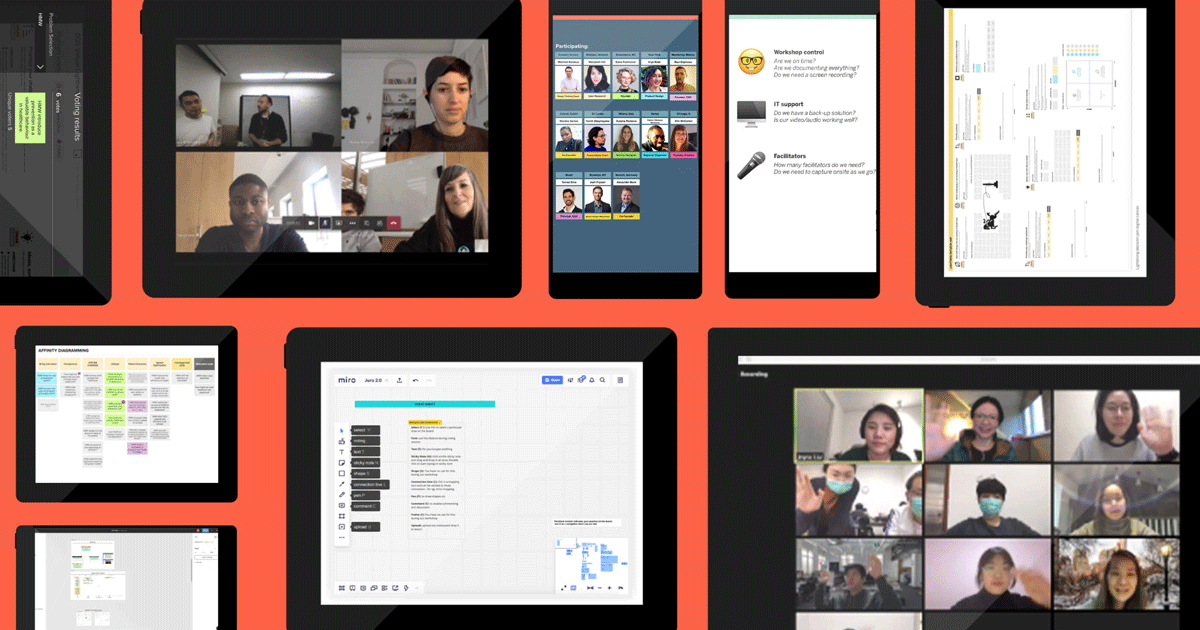
Virtual Events Are the New Normal
As the coronavirus pandemic continues to keep us all socially distanced, virtual events, webinars and conferences have become an essential way for organizations to transition away from in-person experiences. At the start of the pandemic in early 2020, the entire live event and entertainment industry seemed to pause and with it came staggering economic impact. With this transition, and in typical design fashion, we saw an opportunity to think about how the in-person event experience. We got to work redesigning virtual events to include innovative and interactive online end-to-end experiences that would build on essential IRL event elements, including virtual spaces to share stimulating content with attendees, remote tools to foster meaningful interactions and relationships between participants, and virtual spaces for attendees to network and connect. We realized that there was an enormous opportunity to design and build unique virtual emotional experiences by leveraging our remote technology, strategy, and customer experience capabilities.
How can designers impact the virtual event space?
When we received a request from one of the largest media companies to develop a virtual event strategy and experience that would have a lasting impact on participants, we were able to put our “human-centered” lens to the test. Rather than simply trying to recreate the feeling of “in-person” while we’re all quite obviously remote, we dug deep into the objectives of our client’s event requests and needs in order to create concepts for digital products and features that could be easily integrated into common video streaming services. One major goal was to limit screen fatigue and increase virtual engagement; think AI chatbots, AR Totems and virtual conference stages.
Already, there have been excellent examples of innovation in the virtual events arena. The online gaming platform Fortnite launched a completely riveting virtual experience where people could join in with personalized virtual avatars from around the globe to enjoy a new kind of musical journey with Travis Scott, who virtually performed the world premiere of his new album. And when it comes to professional sports, the NBA has made a swift virtual “restart” by integrating new technology into the fan experience, including “Together Mode,” which uses AI to segment and integrate screens so people appear to be closer to each other in the virtual crowd. Fans are also now able to contribute to the game by “digitally cheering” and clapping via their phones on an NBA app. All together, these experiential elements elevate the virtual experience quite gracefully.
In the months since global lockdowns have taken hold, frog has helped multiple organizations make the transition from live to virtual event planning. Although it had not been one of our core capabilities before the pandemic, we (like so many of our client partners) were able to quickly pivot, given that our human-centered approach to experience design offers unique tools to create memorable and meaningful virtual event experiences. Below are some of the most important insights we’ve gained about the planning and execution of virtual events.
Just because your organization has a go-to app for internal meetings doesn’t mean it should also be your go-to app for an external virtual event. To identify the correct platform for hosting your virtual event, consider the audience that will attend the event: Is there a standard virtual platform used in the industry or age group? Are they primarily expecting to receive information or are they expecting to participate and engage with speakers and other attendees? Answering such questions will help you pick the platform that works best for your audience and your event.
As we said, planning a virtual event requires a different set of skills, tools and expertise than planning a live event. That means the people helping to plan, organize and manage a virtual event should be different, too. Be sure to include IT and technology team members on the virtual event team, along with content and event producers to help you identify and troubleshoot problems before (or during) your virtual event.
In the early phases of planning your virtual event, you should identify the core values, content and goals of the event. These factors will affect every aspect of your event design, from the platform you pick to host the event to the sessions and activities that fill the schedule. We’ve found that applying design principles and practices (as well as collaboration software like Miro) during the planning process results in more coherent, impactful and productive event strategies and frameworks.
By this point, we’re all familiar with “Zoom fatigue.” Luckily, there are plenty of tools for making your virtual event more participatory, memorable and engaging. Creating virtual breakout rooms or other themed non-session rooms for participants to have side conversations or meet by chance is one way to help recreate the spontaneous possibilities of a live event. But you can also embrace virtual spaces by exploring fun features like event-specific filters or experiences like collaborative online games.
If you’ve been working remotely during the pandemic, you know that simple technology issues like one participant’s poor internet connection can easily derail a virtual meeting or process. But in addition to planning for such typical technological complications, virtual event organizers must also anticipate new and unfamiliar challenges that can turn a seamless session into a frustrating experience. Your event planning team should try to outline scenarios and responses ahead of time to make sure there’s a plan in place to keep the event running.
In the past year, so many of our routines, tools and expectations have changed. We at frog have needed to adapt along with everyone else, but our diverse capabilities and expertise as experience designers have enabled us to create innovative, unique and memorable virtual experiences for our new remote normal. Partner with frog today to take your organization’s virtual events to the next level.

As a Business Development Associate, Sydney applies design thinking to complex business challenges. Through strategy, marketing, communications, and analytics she is able to uncover unique opportunities for frog and clients in unconventional and strategic ways.

Ioni is an Experience Designer and Event Producer with over 10 years of experience designing and producing live and virtual events, branded activations and exhibitions. As a creative storyteller and interactive technologist, Ioni is passionate about pushing the frontiers of Experiential Marketing at frog and partnering with clients to design and deliver unique and memorable events.
We respect your privacy
We use Cookies to improve your experience on our website. They help us to improve site performance, present you relevant advertising and enable you to share content in social media. You may accept all Cookies, or choose to manage them individually. You can change your settings at any time by clicking Cookie Settings available in the footer of every page. For more information related to the Cookies, please visit our Cookie Policy.


